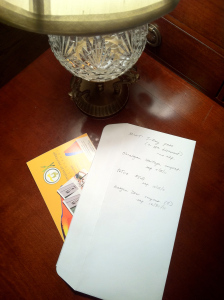According to the Employee Relocation Council (and as anyone who has ever moved surely knows), "moving is the third most stressful event in life, following death and divorce."
Moving requires managing many logistical challenges - and life doesn't halt for you while you get it all done. You still have to face the daily grind of work and home life, when all the while you're drowning in boxes. In addition to all of that, you also encounter the nostalgia of ending one era and the anxiety of beginning a new one. Downsizing is particularly stressful, not only for the labor and planning involved in reducing your possessions but also for the emotional difficulty of parting with your stuff.
I can't promise that moving will ever be much of a picnic but, having assisted with many moves, I can share some universal advice that can make the process a lot less painful.
Planning
Planning is critical to a smooth move. There are several spaces, dates and vendors to manage so first think through all the details and write out your plan, including when each step will occur. Start with your deadline for being settled in the new place and work backwards, accounting for packing and unpacking time, utility appointments, address changes, bill deadlines, furniture deliveries, car or truck rentals, cleaning service visits and walk-throughs.
Carefully plan your new space. Floor plans are not always reliable so take your own measurements, not just of walls and ceilings but also of counter tops, and inside closets and garages. Use a free internet space planner to map out how your furniture will fit into the new space.
Then decide where you will store your belongings. Take a visual inventory of all the categories of items you will bring with you and designate a room, closet or area where each will be accessible. Don't assume you can replicate your current home in the new one. Perhaps you keep your extra linens in the guest closet at your current house but it might make more sense in the new space to keep them in your master bathroom. It's important to have a realistic plan for where everything will go, especially if you're downsizing and might not have enough space for everything you expect to bring along. It also saves time during the move process and means you'll be completely settled in from day 1 (or 2) in the new house.
Packing
Movers pack with only 2 goals in mind: a) getting everything on the truck and delivered to the new house as quickly as possible and b) covering their liability by ensconcing everything - even your Tupperware - in bubble wrap. Hire movers that you know to be honest and reliable. Then work with them to pack smarter.
- Use large, easily visible color-coded stickers to indicate what stays and what goes. Make sure they are adherent enough not to fall off.
- Take photos before packing begins for reference when unpacking, especially of bookcases and other decorative spaces.
- Keep a list or take a photo of the contents of each box.
- Pack items in groups according to where they will go in the new space, NOT where they are in your current space.*
*This saves a huge amount of time and effort in the unpacking process and prevents your having to drag heavy boxes from one room to another on the delivery end. Don't let movers pack "unlikes" in a single box. The office papers in your kitchen should be packed with other office papers - not with coffee mugs.
If you're moving yourself, leave plenty of time and start early by packing things you can do without for a few weeks. Leaving too much to the last minute adds a lot of stress and disorder.
Move day
Get help! You can't be everywhere doing everything so recruit a trusted friend to lend a hand. While you field questions and direct movers, he or she can record box contents and start unpacking some of the crucial items.
Be sure to set aside the personal items you'll need for the 24-hour move cycle. In addition to a change of clothes and a day's worth of toiletries, don't forget:
- Keys
- Wallet, checkbook (with some cash on hand)
- Cell phones and chargers
- Medications
- Alarm clock
- Food and water for the day - for you and your pets (remember a couple of bowls, spoons, forks, etc.)
- Keep some toilet paper and hand soap with you so that it's available at both the old and new locations
You should also hand carry valuable or very fragile items, and plan to transport any open toiletries or cleaning supplies yourself. Movers won't load these in their trucks for fear of damaging spills.
Take care of yourself on move day. Be sure to get a good night's rest. Take breaks throughout the day, and remember to eat and drink. Make special arrangements for young children and pets so that no one gets hurt or lost.
Unpacking
Despite movers' preferences, unload and place furniture in the new house first - before bringing in boxes. Otherwise, the boxes block the way. Once you have your furniture in place, start unpacking one area at a time, clearing as many boxes as possible to make more space. I like to start with clothing and then unpack toiletries and kitchen items. That's usually enough work for one day. Less critical areas, including office items, cleaning and laundry supplies and books, artwork and accessories, can wait a day or two.
Starting out in a new space is an opportunity to set up a more organized home. Rather than rush through the process, take time to plan, downsize your possessions and strategically place items in your new home. It's a lot easier to start off right in a space than to purge and reorganize later on.
One final plea: if, while preparing to move, you unearth boxes still unopened from your last move, do not open them. Do not load them on your moving truck. Barring the remote possibility that they contain bundles of cash, take them straight to the dump.



























